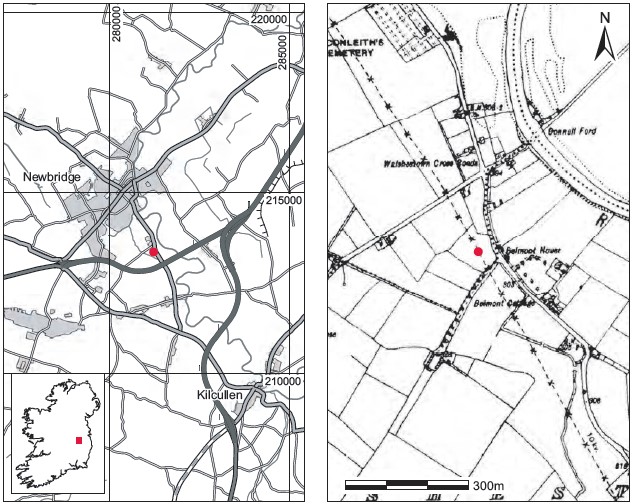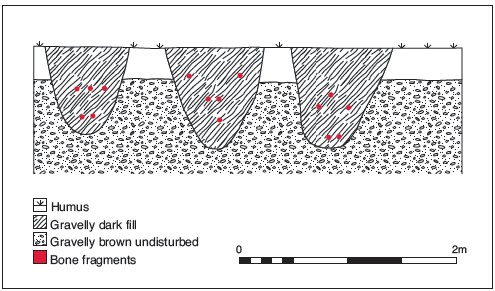County: Kildare Site name: KILBELIN, CO. KILDARE,
Sites and Monuments Record No.: SMR KD023-021 Licence number: E1083
Author: BREANDÁN Ó RÍORDÁIN
Site type: Graves of indeterminate date
Period/Dating: —
ITM: E 681172m, N 713390m
Latitude, Longitude (decimal degrees): 53.164811, -6.786069
Introduction
In May 1966 a number of inhumation burials were found near Newbridge, Co. Kildare, during the digging of foundations for a house with a mechanical digger. A trench 3.2m long by 0.7m wide by 1m deep, running north/south, had been dug into gravelly subsoil. The outlines of three round-bottomed pits containing human bone were noticed in the section. The site was reported to the local Gardaí, who informed the NMI. A rescue excavation was carried out by Breandán Ó Ríordáin. A cutting extending at right angles from the machineexcavated trench was opened in order to investigate the burials.22 As there was nothing to indicate a date for the graves, Ó Ríordáin decided not to continue the excavation and requested that the local coroner and health board be informed. The exact number of graves at the site is therefore not known, although three pits were visible in section. The human remains from the site were examined by Professor J.B. Coakley. This report is based on Coakley’s analysis of the bones and Ó Ríordáin’s excavation report and illustrations.
Location (Fig. 6.15)
The site is in the townland of Kilbelin, Co. Kildare.23 It lay in a relatively flat field at an altitude of c. 90–120m above sea level, 1.5km south of Newbridge town. The site is not marked on the first edition OS 6in. sheet, but according to local tradition there was a cemetery in the field.


Description of site
The graves were dug to a depth of between 0.78m and 0.9m below the ground surface. They lay on average 0.24m apart. The pits measured approximately 0.8m wide at the top and narrowed to 0.3–0.45m at the base. Although at least three graves originally existed on the site, only one is described in detail by the excavator (Fig. 6.16). The bone occurred at a depth of 0.46m below ground level. The burial was aligned east/west but there was no formal gravelining, and no structural slabs were noticed near the grave. The grave contained an articulated inhumation and disarticulated bone. An adult skull was also found lying over the toe bones of the complete skeleton, and some other disarticulated bone was found around the lower limbs of the burial. Two of these individuals were adults and two were children. It was apparent that a number of individuals had been buried in this particular grave, and that in the course of interment of later burial(s) an earlier burial had been disturbed. Bones, exposed at various points in the section faces of the previously mentioned pits, also suggest that these graves contained more than one skeleton. Skulls of four individuals were collected from the site. One was the skull of an adult male; one was of an elderly individual of unknown sex; the third was of a juvenile of unknown sex, while the fourth was the skull of an infant of less than one year old. All human remains were registered as 1968:423.
Comment
Owing to the circumstances of discovery and the limited nature of the investigation it is not possible to suggest a date for this burial
.
HUMAN REMAINS
J.B. COAKLEY
The collection (1968:423) comprised fragments of four human skulls and a fragment of one human clavicle.
Skull no. 1
This is a fairly complete skull, although the mandible and maxillae are missing. The vault, however, is complete and all sutures of the vault are open. The skull appears to be of average size. Conclusion: adult skull, probably male.
Skull no. 2
This is also an incomplete specimen. Part of the vault and mandible are missing. There is partial fusion of the sutures. The mandibular fragment indicates that the skull is that of an elderly individual. The second and third molar teeth have been lost during life and the only tooth remaining shows marked wear.
Conclusion: this is the skull of an elderly individual of unknown sex.
Skull no. 3
This is represented by a small portion of the vault and a fragment of the base. There was also a fragment of the clavicle of this skeleton. It was not possible to determine the sex. Conclusion: the skull would appear to be that of a young child of unknown sex.
Skull no. 4
This skull was represented by a small fragment of mandible. It is probably from an infant of less than one year of age.
22. Part of a clay pipe and some china were found in the topsoil in this area.
23. Parish of Greatconnell, barony of Connell. SMR KD023-021——. IGR 281240 213360.